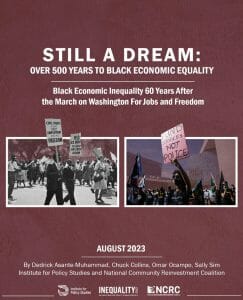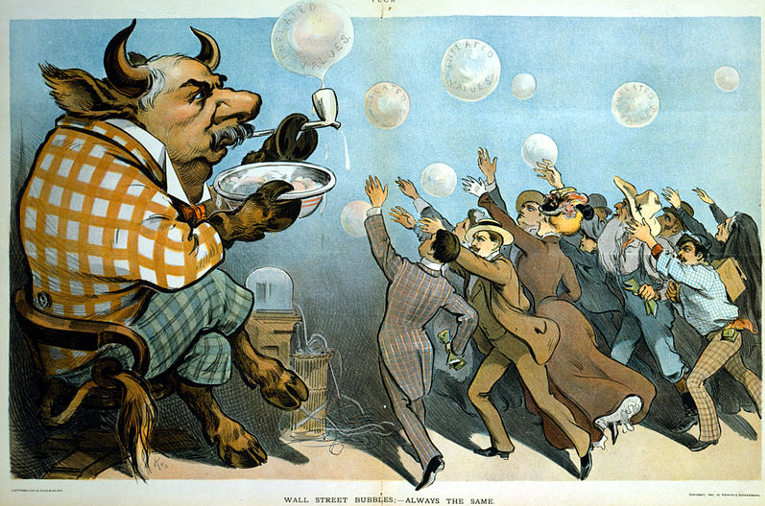Black Americans have endured the unendurable for too long. Sixty years after the famed March on Washington for Jobs and Freedom, where Dr. Martin Luther King, Jr., gave his landmark “I Have a Dream” speech, African Americans are on a path where it will take 500 more years to reach economic equality.
A new report, Still A Dream, coauthored by Institute for Policy Studies and the National Community Reinvestment Coalition, examines the economic indicators since 1963. Our country has taken significant steps towards racial equity since the Civil Rights Movement of the 1950s and ‘60s. But growing income and wealth inequality over the last four decades has supercharged historic racial wealth disparities, slowing and even reversing many of those gains.
Sixty years without substantially narrowing the Black-white wealth divide is a policy failure. But just as federal policy helped create the racial wealth gap, it can also help close it. In this report, we look in detail at the state of that divide and recommend policy reforms that would substantially narrow it within one to two generations.

The full version of the report is available here. A summary follows.
Key Findings
In a few areas, African Americans have made substantial socioeconomic advancements since the 1960s.
- In 1963, Black Americans had a stunningly high poverty rate of 51 percent, compared to 15 percent for white Americans. By 2021, poverty rates had declined, with white poverty at 8 percent and Black poverty at 20 percent. Though this is a substantial decline, it still means almost one in 12 white Americans are in poverty and one in five Black Americans live in poverty.
- The rate of Black high school attainment has sharply increased over the past 60 years, from 24.8 percent in 1962 to 90.1 percent in 2022. But while the college attainment advantage for whites in 2022 (1.7 times that of Black Americans) was substantially lower than it was in 1962 (2.4 times), there is still a substantial divide between Black college attainment (27.6 percent) and white college attainment (37.9 percent).
- Unemployment has been historically low for African Americans over the last few years. Between 1974 and 1994, Black unemployment consistently remained in the double digits, with rates twice as high as those for white Americans. From 1994 to 2017, Black unemployment rates varied between 7 percent and 10 percent, occasionally spiking to nearly 17 percent during recessions. However, since 2018, Black unemployment has reached record lows of 5 percent and 6 percent, except during the 18-month recession caused by COVID-19.
Yet there has been minimal progress in most socioeconomic indicators. At this pace, it would still take centuries for African Americans to reach parity with white Americans.
- For every dollar of white family income, African Americans had 58 cents in 1967. In 2021 African Americans had 62 cents to the white household’s dollar. At this rate, it would take Black households 513 years to reach income parity with white households.
- Median household income for African Americans has grown just 0.36 percent since the turn of the century and it is still lower today than the white median family income in 1963.
- In 1962, African Americans had 12 cents for every dollar of wealth of non-Black Americans. By 2019, African Americans had 18 cents for every dollar of wealth of non-Black Americans. At this rate it would take 780 years for Black wealth to equal non-Black wealth.
- Black homeownership increased from 38 percent in 1960 to 44 percent in 2021, an increase of 6 percentage points. White homeownership has increased from 64 percent in 1960 to 74 percent in 2021, a 10 percentage point increase. In over 60 years, there has not been a bridging of the Black-white homeownership divide.
Solutions and Interventions
“Depressed living standards for Negroes are not simply the consequences of neglect. Nor can they be explained by the myth of the Negro’s innate incapacities, or by the more sophisticated rationalization of his acquired infirmities. They are a structural part of the economic system in the United States.”— Dr. Martin Luther King, Jr., 1968
There are a wide range of solutions necessary to narrow the racial economic divide. The five that we believe would make the most difference are:
- A push for full employment and guaranteed jobs.
- A massive land and homeownership program.
- A commitment to individual asset building.
- Policies to reduce dynastic concentrations of wealth and power.
- Targeted reparations and universal health care.






